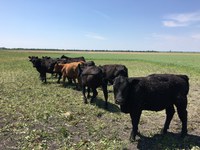Cover Crops an Option for Prevented Plant Acres
(Click the image below to view a high-resolution image that can be downloaded)
With most of the spring planting wrapped up in North Dakota, some areas of the state have large areas of prevented plant acres because of excessive moisture.
Typical for North Dakota, other areas of the state are in a drought situation.
Planting cover crops is an option to consider in managing your prevented plant acres, says Ron Haugen, North Dakota State University Extension farm management specialist.
Rules for planting cover crops on prevented plant acres must be followed. The Farm Service Agency (FSA) requires the acreage to be protected from water and wind erosion. The FSA considers most any crop planted for the purpose of erosion control, soil health improvement and water quality improvement as a cover crop.
Haugen cautions, “Check with the FSA for questions on cover crop types. Cover crops may be hayed or grazed, but the primary use must be for cover.”
The dates that haying or grazing are allowed on prevented plant acreage are determined by the Risk Management Agency (RMA). The current rule states that no haying or grazing is permitted before Nov. 1. At this time, the RMA has no plans to change that date. Haying or grazing cover crops before that date will significantly impact your prevent plant insurance payment.
A producer may plant cover crops within the late planting period. With this option, the producer is eligible for the full insurance indemnity payment, provided the cover crop is not hayed or grazed before Nov. 1. The late-planting period is typically 25 days after the final planting date for most crops.
“Under this scenario, if a producer does hay or graze prior to Nov. 1, all of the insurance indemnity is forfeited,” says Haugen. “This would be very costly.”
A producer who plants cover crops after the late planting period and hays or grazes after Nov. 1 will get the total insurance indemnity. A producer who plants a cover crop after the late-planting period and utilizes the acreage for haying and grazing prior to Nov. 1 will be penalized.
This option results in a 65% reduction in the crop insurance indemnity payment. This is a costly option. The value of cover crops for haying and grazing must offset this loss.
Haugen notes, “Keep in contact with the FSA and your crop insurance agent for current rules and rule updates.”
NDSU Agriculture Communication – June 24, 2020
| Source: | Ron Haugen, 701-231-8103, ronald.haugen@ndsu.edu |
|---|---|
| Editor: | Kelli Anderson, 701-231-6136, kelli.c.anderson@ndsu.edu |


